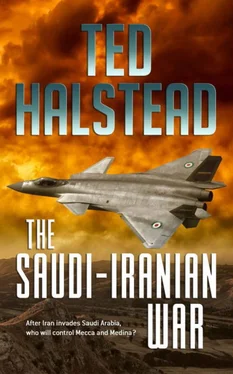Ted Halstead - The Saudi-Iranian War
Здесь есть возможность читать онлайн «Ted Halstead - The Saudi-Iranian War» весь текст электронной книги совершенно бесплатно (целиком полную версию без сокращений). В некоторых случаях можно слушать аудио, скачать через торрент в формате fb2 и присутствует краткое содержание. Год выпуска: 2019, Издательство: Independently published, Жанр: Боевая фантастика, Триллер, на английском языке. Описание произведения, (предисловие) а так же отзывы посетителей доступны на портале библиотеки ЛибКат.
- Название:The Saudi-Iranian War
- Автор:
- Издательство:Independently published
- Жанр:
- Год:2019
- ISBN:нет данных
- Рейтинг книги:4 / 5. Голосов: 1
-
Избранное:Добавить в избранное
- Отзывы:
-
Ваша оценка:
- 80
- 1
- 2
- 3
- 4
- 5
The Saudi-Iranian War: краткое содержание, описание и аннотация
Предлагаем к чтению аннотацию, описание, краткое содержание или предисловие (зависит от того, что написал сам автор книги «The Saudi-Iranian War»). Если вы не нашли необходимую информацию о книге — напишите в комментариях, мы постараемся отыскать её.
The Saudi-Iranian War — читать онлайн бесплатно полную книгу (весь текст) целиком
Ниже представлен текст книги, разбитый по страницам. Система сохранения места последней прочитанной страницы, позволяет с удобством читать онлайн бесплатно книгу «The Saudi-Iranian War», без необходимости каждый раз заново искать на чём Вы остановились. Поставьте закладку, и сможете в любой момент перейти на страницу, на которой закончили чтение.
Интервал:
Закладка:
Jamal rode in the cupola of his M1A2 tank as he and the rest of his armor rolled towards the invaders, and chewed his lower lip as he thought about anything else he could do to improve their chances. Finally, he shook his head.
He had done all he could. Very soon, he would find out whether it had been enough.
Colonel Hamid Mazdaki nodded at the scout’s report. It was about time the enemy showed himself. He frowned, though, at the estimate that half the tanks he was facing were M60 Pattons, with the other half the M1A2s he’d been expecting as his sole opponents. Since elements of the M60s Iran had bought from the Americans before the Revolution had been used to develop the Zulfiqar-3 he was sitting in, it’s not that he dismissed them as a threat.
No. Instead, Hamid’s first thought was that the force in front of him was a decoy, intended to distract him while another armor force struck him on the flanks.
Hamid shook his head as he read more reports. Part of his purpose in staying away from highways most of the way had been to avoid a surprise flanking attack, and the terrain he’d picked for his approach to Riyadh had effectively guaranteed against one. There were escarpments on both sides of his force that would halt any flank approach.
By tanks. Hamid froze in his cupola as he thought to himself — What about helicopters?
He dropped into the tank to access its communications console.
“Commander Khalilli, can your missile launcher defend us from helicopter attack?”
Khalilli’s voice in response sounded genuinely puzzled. “Yes, sir. The S-300’s radar will spot helicopters even at low altitude from over a hundred kilometers away.”
Hamid gritted his teeth. “I’m not talking about helicopters approaching us on this plateau. What if they flew along the escarpment, and popped up alongside us at the last moment?”
There was a long pause, which Hamid let continue without comment. He wanted the man to think.
“Sir,” Khalilli said carefully, “I am glad you brought that possibility to my attention. It is a likely tactic, since I understand the enemy has Apache helicopters. Our crew will be watching for any sudden appearance by unknown contacts, and engage them immediately. Without this conversation, we might have thought such contacts an anomaly. Now, we will understand just how they could have appeared close to us without prior warning.”
Hamid grunted. “Good, Commander. Enemy armor is approaching. I think it’s likely Apaches are going to join in the attack as soon as their tanks are in range.”
“Very well, sir,” Khalilli said confidently. “We’ll be ready.”
Hamid ordered his T-90s and the Armata to the front of his force, and along with the other Zulfiqar-3s fell in behind them. Though ready to die, Hamid wasn’t about to take unnecessary risks until they got to Riyadh.
The 2A46 125 mm smoothbore cannon in the T-90 could fire multiple types of ammunition, but for this battle had been loaded with armor-piercing fin-stabilized discarding sabot rounds. These particular rounds were the 3BM44M “Lekalo” with tungsten alloy sabots which would be fired at a muzzle velocity of 1,750 meters per second, and had the ability to penetrate 650 mm of armor at a range of two kilometers.
The T-90 had an autoloader that carried twenty-two ready-to-fire rounds in its carousel, and could reload in less than eight seconds. That meant Hamid’s ten T-90 platoons would be able to deliver nearly nine hundred Lekalo rounds with only three minutes needed to reload the shells.
Of course, that didn’t include the time needed to aim the T-90’s cannon accurately. This had been a major worry for Hamid prior to his unit’s last deployment to Syria, their first after receiving the T-90. Their T-90MS tanks included the same “Kalina” automatic target tracker and fire control computer installed in the T-14 Armata. Capable of automatically tracking and continuously locking the T-90’s main gun on a target, it had been a godsend for Hamid, since he had not been able to spend as much time as he’d have liked on training many of his tanks’ crewmen.
Now Hamid was going to see just how effective the T-90 was against the Saudis. Since the best the Syrian rebels had managed to field against him had been some captured T-55 Syrian Army tanks, all he knew for sure was that this would be a greater challenge.
The Kalina system had locked in the M60s as valid targets from a range of nearly four kilometers, in spite of the Pattons’ deployment of a smoke screen.
Since Hamid had ordered the T-90s’ gunners to wait until the M60s were in the Lekalo rounds’ maximum effective range of three kilometers, it gave him plenty of time to ensure they were aiming at separate M-60s.
When the T-90s opened fire on the Pattons, not a single M60 had tried to engage the enemy tanks. Hamid correctly concluded that the M60s’ commander didn’t believe they had a real chance of hitting his tanks from a three-kilometer range.
The same was certainly not true for his T-90s. Their initial salvo left thirty-eight M60s either immobile or destroyed, with most actually catastrophic hits. Even from three kilometers, Hamid could see multiple tank turrets thrown clear either by the force of a direct sabot hit, or by secondary explosions of fuel and ammunition inside the Pattons.
Now there was finally answering fire, as the enemy’s M1A2 tanks rolled forward to replace the Pattons. At the same time, Hamid was notified over his headset that Apache helicopters had launched the attack he’d expected. Two minutes later Commander Khalilli told him four Apaches had been destroyed, and for now there were no other contacts.
So far in spite of the Abrams tanks’ best effort only three hits had registered against Hamid’s T-90s, and only a single hit had actually managed to kill one. This impressive record was due to the T-90’s three-layer defensive approach. The first was the T-90’s composite armor, the second its Kontact-5 explosive reactive armor, and the third its Shtora-1 countermeasures suite. Shtora-1 included two active infrared jammers, four laser warning receivers, and two smoke grenade launchers that deployed automatically whenever the T-90 was painted by an enemy targeting system.
By contrast, the Saudi M1A2 tanks lacked the depleted uranium that made the American models difficult to penetrate, had no reactive armor, and manually deployed smoke. Many were killed so quickly they never had the chance, not that it would have mattered. The real surprise was that at a three-kilometer range they were able to damage the T-90s at all.
Just as Hamid thought uneasily that the battle was going too well, Commander Khalilli was yelling over his headset, “Attack drones!” An instant later, a loud explosion behind his tank sent ice through his veins, as he thought to himself the launcher must have been hit.
Several minutes later, Hamid’s fears were proved groundless as Commander Khalilli’s voice came over his headset again to report that three Reaper attack drones had been shot down, and that once again there were no enemy air contacts visible. He also reported that the R-330ZH automated jammer had been destroyed as well as several of their tanks, though he couldn’t say which model. Hamid shook his head with resignation, acknowledging to himself that knowledge of all the different tank models Iran was currently fielding was a bit too much to expect from his missile launch commander.
A quick look answered his principal question- had one of the tanks the Reapers destroyed been the Armata? The answer “no” came in the form of the T-14 firing a 9M119M Refliks anti-tank missile at a Saudi M1A2. With the ability to punch through nearly a meter of armor, any hit was likely to be a kill. So far, the Armata had accounted for the destruction of seven M1A2 tanks on its own, and still stood untouched.
Читать дальшеИнтервал:
Закладка:
Похожие книги на «The Saudi-Iranian War»
Представляем Вашему вниманию похожие книги на «The Saudi-Iranian War» списком для выбора. Мы отобрали схожую по названию и смыслу литературу в надежде предоставить читателям больше вариантов отыскать новые, интересные, ещё непрочитанные произведения.
Обсуждение, отзывы о книге «The Saudi-Iranian War» и просто собственные мнения читателей. Оставьте ваши комментарии, напишите, что Вы думаете о произведении, его смысле или главных героях. Укажите что конкретно понравилось, а что нет, и почему Вы так считаете.












